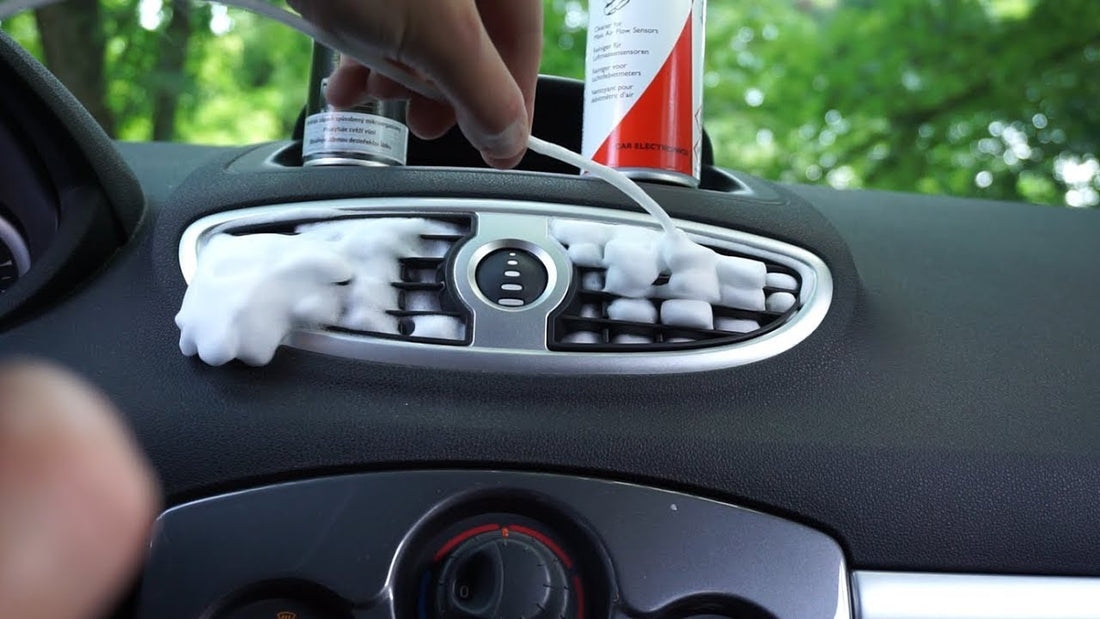
أهمية نظافة نظام تكييف السيارة (A/C)
المكوّن المُهمل في نظافة السيارة... واللي بيفرق كتير في راحتك وصحة عربيتك
في وسط روتين العناية بالسيارة—من تلميع الطلاء إلى تفريغ الأتربة وتغيير الزيت—بيفضّل نظام التكييف يفضل في الخفاء، بالرغم من إنه بيشتغل ويزوّد الأجواء بجزيئات دقيقة كتير لوحده داخل المقصورة.
أهمية نظافة نظام تكييف السيارة (A/C)
نظام التكييف مش بس رفاهية، هو جزء أساسي من منظومة صحة سيارتك. بيأثر على جودة الهواء داخل الكابينة، راحة الركاب، وطول عمر مكونات التكييف على المدى الطويل.
فهم تركيب نظام تكييف السيارة
يتكوّن النظام من: مبخّر (Evaporator)، ضاغط (Compressor)، مكثّف (Condenser)، وصمام التوسع. المبخّر، الموجود غالبًا وراء الطبلون، هو أكثر الزيت الذي يتراكم عليه الأتربة والنمو الميكروبي.
كيف بتدخل الملوثات للنظام؟
الغبار، حبوب اللقاح، الرطوبة وحتى الحشرات تقدر تدخل لنظام التكييف من خلال فتحات الهواء. ومع الوقت، البيئة الرطبة دي بتبقى بيئة مثالية لتكاثر العفن والبكتيريا.
علامات تدل إن التكييف محتاج تنظيف
-
روائح كريهة أو معفّنة
-
ضعف تدفق الهواء
-
تكوّن بخار أو ضباب على الزجاج
-
ظهور أعراض حساسية على الركاب
الريحة المحتاجة عادةً بتكون العلامة الأولى على نمو ميكروبات داخل القنوات.
عواقب إهمال تنظيف التكييف
1. مخاطر صحية
العفن والبكتيريا ممكن يسببوا مشاكل في التنفس، احتقان الأنف، وزيادة أعراض الربو، خصوصًا لأصحاب المناعة الضعيفة.
2. انخفاض كفاءة الأداء وارتفاع استهلاك الوقود
انسداد الفتحات والمبخّر بيخلي التكييف يشتغل بضغط أعلى، وده بيسبب استهلاك وقود أكبر وضغط على الكمبريسور.
3. روائح تنذّر بعمق المشكلة
ريحة كريهة مش مجرد عفن؛ ممكن تدل على تسريب فريون أو تلف أجزاء داخلية. لازم تاخدها على محمل الجد.
أنواع منظفات تكييف السيارات
-
Aerosol Foggers (بخاخات الضباب): تعبّي المقصورة بدهان معقّم. حل سريع لروائح بسيطة، لكنه واقِعي سطحي.
-
منظفات رغوية (Foam Cleaners): تُحقّن مباشرة داخل النظام، والـ foam بينظّف العمق بكل قوة.
-
بخاخات مطهّرة (Disinfectant Sprays): تنقّع فتحات الهواء وتقلّص البكتيريا. مناسبة كصيانة دورية ما بين التنظيف العميق.
-
البدائل الطبيعية DIY (الخل، زيت شجرة الشاي): فعّالة بشكل طبيعي، لكنها أقل قوة من المنتجات المتخصصة.
كيف بتنظف منظفات التكييف؟
معظم المنظفات تحتوي على مواد مثل الأمونيوم الرباعي أو الكحول، إللي بتكسر أغشية الكائنات الدقيقة وتقلّل نشاطها.
الرغوة أو البخاخات بتخترق بقايا الأوساخ وتفكروها من الجذور.
لكن النتائج مش دايمًا دائمة—يُفضل إعادة التنظيف كل 3 إلى 6 شهور.
اختيار المنظف المناسب لعربيتك
اختر بما يناسب نوع سيارتك، حالة التلوث، وحساسية الركاب. مهم تتأكد أنه آمن للمواد الداخلية في التكييف.
منتجات مثل ABRO A/C Deodorizer Lemon وABRO AIR CLEAN أثبتت فاعليتها في السوق المصري وبتوفر:
ABRO A/C Deodorizer Lemon
-
فعّال في القضاء على الروائح داخل مقصورة وسيستم التكييف، ويترك رائحة ليمون منعشة.
ABRO AIR CLEAN
-
منظف ومعطر قوي لفتحات التكييف، يزيل العفن والروائح، وينشط التهوية بكفاءة.
إحنا في أبرو مصر بنوفر تشكيلة من منتجات العناية بالمقصورة والتكييف، صُممت لمقاومة الظروف اليومية والعوامل البيئية في مصر.
خطوات استخدام منظف تكييف فعّال
-
اركن العربية في مكان مفتوح ولبس قفازات ونظارات أمان.
-
شغّل المحرك وحوّل التكييف على وضع “Recirculation” وساقع وνير أقصى مدى.
-
استخدم المنظف المناسب (Fogger أو Foam أو Spray)، طبق حسب التعليمات.
-
بعد 10 دقائق، افتح الأبواب للنّفاذ الجوي لعدة دقائق، واستبدل فلتر الكابينة.
تنظيف احترافي أم منزلّي؟
-
التنظيف بنفسك اقتصادياً وسريع.
-
أما لو الروائح مستمرة أو في عفن ظاهر، يفضل أن تستعين بفني مؤهل لتنظيف عميق.
استراتيجيات الحفاظ على نظافة التكييف
-
غيّر فلتر الكابينة بانتظام (كل 10,000–15,000 كم أو سنويًا).
-
أخلي النوافذ مغلقة في المناطق الغبارية.
-
اعمل تنظيف موسمي بالتكييف—قبل الصيف وبعده لصد الغبار والعفن.
الخلاصة: هواء نقي... وقيادة أنقى
نظام تكييف نظيف يعمل على تحسين صحتك، راحة الركاب، استهلاك الوقود، وقيمة سيارتك السوقية.
مع منتجات أبرو مصر المتاحة بأفضل جودة، خلي تكييف عربيتك دايمًا في أبهى حالاته.
